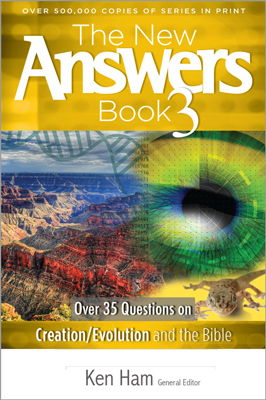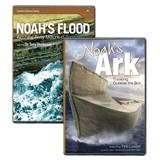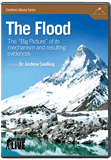
Chapter 6
Was the Flood of Noah Global or Local in Extent?
This is ultimately about the authority of God’s Word, which plainly teaches that the Flood of Noah was global in extent.
Whether the Flood of Noah was global or local in extent is a crucial question.
Many Christians and their leaders believe that it is not relevant whether the Flood of Noah described in Genesis 6–8 was global or localized (in the Mesopotamian Valley of the Tigris and Euphrates Rivers). After all, they say, it's not relevant to a Christian's salvation, and the gospel message to be preached is all about Jesus.
Besides, matters about rocks and the earth's history are the domain of the geologists, because the Bible isn't a science textbook. So if the geologists say there never was a global Flood, then that settles it! Thus, Christians who advocate an old earth agree with the secular geologists, and therefore they oppose any notion that the Flood of Noah was global.
However, whether the Flood of Noah was global or local in extent is a crucial question. This is because ultimately what is at stake is the authority of all of God's Word. Indeed, if the text of Scripture in Genesis 6–8 clearly teaches that the Flood was global and we reject that teaching, then we undermine the reliability and authority of other parts of Scripture, including John 3:16. God's Word must be trustworthy and authoritative in all that it affirms.
Millions of Years or a Global Flood?
Secular geologists have interpreted the fossil-bearing sedimentary layers, such as those exposed in the walls of the Grand Canyon, as having taken millions of years to form. Countless sea creatures lived on shallow seafloors, for example, and were slowly buried, to be replaced by new sea creatures growing on the seafloors. The various sedimentary rock layers that we now see stacked up on top of one another thus supposedly slowly accumulated as sea creatures were progressively buried.
The guiding principle used by secular geologists to interpret the rock record is “the present is the key to the past,” which means that the geologic processes we see operating today, at the rates they operate today, are all that are necessary to explain the rock layers (Figure 1). While catastrophes such as local flooding and volcanic eruptions are allowable because they do occur today, any suggestion of a global catastrophic Flood as described in the Bible is totally ruled out before the geological evidence is even examined.
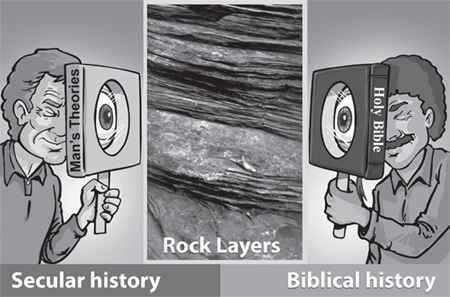
Figure 1. Two views of the rock layers: the world teaches that the vast majority of the rock layers were laid down slowly over millions of years; but in light of a global Flood in Genesis 6–9, it makes more sense that bulk of the rock layers that contain fossils were laid down during this catastrophe only thousands of years ago.
On the other hand, the description of the Flood in Genesis 6–8 is not hard to understand. We are told that the “fountains of the great deep” burst open and poured water out onto the earth's surface for 150 days (five months). Simultaneously, and for the same length of time, the “floodgates of heaven” were open, producing torrential global rainfall.1
The combined result was that the waters destructively rose across the face of the earth to eventually cover “all the high hills under the whole heaven.” The mountains also were eventually covered, so that every creature “in whose nostrils is the breath of life” perished. Only Noah, his family, and all the air-breathing, land-dwelling creatures he took on board the ark were saved.
Based on that clear description of this real historical event, it is very rational to conclude that we should expect to find evidence today of billions of dead animals and plants buried in rock layers composed of water-deposited sand, lime, and mud all around the earth. And indeed, that's exactly what we do find—billions of fossils of animals and plants buried in sedimentary rock layers stretching across every continent all around the globe.2 So instead of taking millions of years to form, most of the fossil-bearing sedimentary rock layers, as seen in the walls of the Grand Canyon and elsewhere, could have formed rapidly during the year of this global catastrophic Flood of Noah.3
It should immediately be obvious that these two interpretations of the evidence are mutually exclusive! Most of these rock layers are either the sobering testimony to Noah's Flood or the record of millions of years of history on this earth. One must be true and the other must be false. We can't consistently or logically believe in both, because the millions of years can't be fitted into the 370-day length of the global cataclysmic Flood of Noah described in Genesis 6–8. That is ultimately the fundamental reason why many old-earth advocates in the Christian community oppose the clear teaching of Scripture that the Flood was global. Only a relatively insignificant local flood would fit with the secular geological interpretation of millions of years of slow and gradual geologic processes for most of the fossil record.
Biblical Problems
In order to relegate Noah's Flood to being only local in extent, and/or to being a myth, the Hebrew text of Genesis 6–8 and also the larger context have to be virtually ignored.
The Book of Genesis is clearly divided into two main sections. Chapters 1–11 deal with universal origins (the material universe, the plant and animal kingdoms, humans, marriage, sin, death, redemption, the nations of the earth, etc.). Chapters 12–50, on the other hand, concentrate on the particular origin of the Hebrew nation and its tribes, mentioning other nations only insofar as they came in contact with Abraham and his descendants.4
The realization of this fact of the context of the Flood account within the section of Genesis on universal origins sheds important light on the question of the magnitude of the Flood. Furthermore, the biblical account of the Flood catastrophe occupies more than 3 chapters of these 11 chapters on universal origins, while only 2 chapters are devoted to the creation of all things! How important, therefore, must the Flood account be! Yet nobody denies that the account in Genesis 1–2 of the creation of all things is referring to the scale of the whole earth, and indeed the whole universe. Thus the context of Genesis 6–8 demands that the scriptural narrative be understood to be describing a watery catastrophe of global proportions.
But when we read the Flood account itself, we see this conclusion confirmed.
We are immediately struck with prolific usage of universal terms such as “all
,”
“every
,” “under heaven
,” and “in whose nostrils was the breath of life.
” For
example, Genesis 6:7–13 tells us why God sent the Flood judgment:
The Lord said, “I will blot out man whom I have created from the face of the land, from man to animals to creeping things and to birds of the sky; for I am sorry that I have made them.” . . . God looked on the earth, and, behold, it was corrupt; for all flesh had corrupted their way upon the earth. Then God said to Noah, “The end of all flesh has come before Me; for the earth is filled with violence because of them; and, behold, I am about to destroy them with the earth” (NASB).
Note in particular God's emphasis on “all flesh
” and “the earth
,” not just
some flesh or part of the earth. Also, note that the Flood came to destroy animals
and birds, not just sinful humans. The Apostle Paul tells us in Romans 8:19–23
that the whole non-human creation was subjected to the Curse because of man's
sin, and thus the whole of creation suffers death and decay. So also in the
Flood, the non-human creation suffered, regardless of whether animals or birds
had come into close contact with sinful man or not.
Then when the Flood began, we are told in Genesis 7:11–12 that “all the fountains
of the great deep (were) broken up,” and “the rain was upon the earth.
” Again,
the words “all
” and “the earth
” are clearly intended to imply global extent.
Indeed, this usage of universal terms is prolific as the Flood account reaches
a crescendo in Genesis 7:18–24:
The waters prevailed, and greatly increased on the earth. . . . And the waters prevailed exceedingly on the earth, and all the high hills under the whole heaven were covered. . . . and the mountains were covered. And all flesh died that moved upon the earth . . . every creeping thing . . . and every man: All in whose nostrils was the breath of the spirit of life, all that was on the dry land, died. So He destroyed all living things which were on the face of the ground. . . . They were destroyed from the earth. . . . And the waters prevailed on the earth one hundred and fifty days.
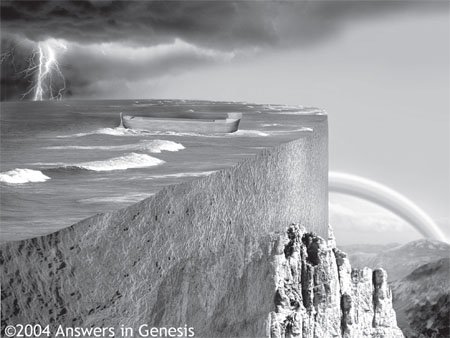
Figure 2. A flood that covered the highest hills by a significant amount, yet was local does not make sense!
So frequent is this use of universal terms, and so powerful are the points
of comparison (“high hills
,” “whole heaven
,” and “mountains
”), that it is extremely
difficult to imagine what more could have been written under the direction of
the Holy Spirit to express the concept of a global Flood! In the words of a
leading Hebrew scholar of the 19th century, who strongly opposed those who tried
to tone down the universal terms of the Genesis Flood account:
They have distorted the spirit of the language, and disregarded the dictates of common sense. It is impossible to read the narrative of our chapter (Genesis 7) without being irresistibly impressed that the whole earth was destined for destruction. This is so evident throughout the whole of the description, that it is unnecessary to adduce single instances. . . . In our case the universality does not lie in the words merely, but in the tenor of the whole narrative.5
Something else in the Flood account is irreconcilable with the Flood being
localized in the Mesopotamian Valley. In Genesis 7:20 we are told that “the
mountains were covered.
” Because water always seeks its own level, how could
the mountains only be covered in one local area without also covering the mountains
in all adjoining areas and even on the other side of the planet (Figure 2)?
This clear statement in God's Word only makes physical and scientific sense
if the Flood were global in extent.
Even the renowned and theologically liberal Hebrew scholar James Barr, then Oriel Professor of the Interpretation of Holy Scripture at Oxford University in England, was prepared to admit in a letter to David C.C. Watson dated April 23, 1984:
. . . so far as I know, there is no Professor of Hebrew or Old Testament at any world-class university who does not believe that the writer(s) of Genesis 1–11 intended to convey to their readers the ideas that . . . Noah's Flood was understood to be world-wide and extinguish all human and animal life except for those in the Ark. Or to put it negatively, the apologetic arguments which suppose . . . the flood to be a merely local Mesopotamian flood are not taken seriously by any such Professors, as far as I know.6
Theological Problems
If the Flood were only a relatively recent local event of no geologic significance, then the fossil-bearing sedimentary layers that were supposedly laid down over millions of years must have preceded the appearance of man on the earth, including Adam. After all, man only appears very recently in the fossil record. For a Christian who accepts the millions of years, this would mean that animals were living, dying, suffering disease, eating each other, and being buried and fossilized prior to Adam's appearance in the Garden of Eden. In the geologic record we find the fossilized remains of fish eating other fish, animals eating other animals, animals with diseases like cancer, and much more, which indicates that these fossils are a record of disease, violence, and death.
However, theologically there is a big problem here. In Genesis 1:30–31
we are told that when God created all the animals they all were vegetarians,
and that God was pleased with everything that He had created because it was
“very good
.” This means that all of creation was perfect when measured against
the goodness of God—the only standard God uses (Matthew 19:17).
Furthermore, it is not until after God pronounced the Curse on all of creation because of Adam and Eve's disobedience that we are told that the ground would bring forth thorns and thistles (Genesis 3:17–18). But the evolutionary geologists tell us that there are fossilized thorns in Canadian sedimentary layers that are supposedly 400 million years old.7 The Bible-believing Christian cannot accept this age-claim however.
If the plain statements of God's Word have any authority, then these fossilized thorns could only have grown after the Curse, after Adam was created by God. So the geologic record in which these fossilized thorns are found could only have been deposited after the Curse. However, the only event after the Curse that could have been responsible for burying and fossilizing these thorns, and the billions of other plants and animals we see in the vast rock layers of the earth, is the year-long Genesis Flood. This then rules out the millions of years.
Another theological problem arises when we come to Genesis 9:11–15. God made
a promise to Noah and his descendants that “never again shall there be a flood
to destroy the earth.
” In other words, God was promising never to send another
event like the one Noah experienced, where we are told specifically in Genesis 7:21 that “all flesh died
.”
Obviously, if the Flood of Noah were only local in extent, then because we have seen lots of local floods since the time of Noah, that have destroyed both man and animals, God has broken His promise many times over! To the contrary, this rainbow covenant God made with Noah and his descendants could only have been kept by God if the Flood were global in extent, because never since in human history has a global flood been experienced.

The Views of Jesus and the New Testament Authors
The Lord Jesus Christ, God's living Word (John 1:1–3), made special reference
to Noah and the Flood in Luke 17:26–30, where He said that, “the Flood came
and destroyed them all
.”
There is no biblical or logical reason to assume that all of pre-Flood humanity was living in the Mesopotamian Valley. Genesis 4 indicates that early man built cities, had nomadic herds of animals, invented things, and explored the earth (v. 17–22). So if all the ungodly globally on the earth will be judged when He comes again, when Jesus by way of comparison describes the Flood and all the ungodly being destroyed by it, then He was saying that the Flood also was global.
Similarly, the Apostle Peter in 2 Peter 3:3–7 warned
of last-days scoffers who would wilfully forget that after the earth was created
by God, it perished, “being flooded with water
,” and that the present earth
is “reserved for fire until the day of judgment
.” There are three events he
is thus referring to: the creation of the world (Greek kosmos), the destruction
of that world (Greek kosmos) by a watery cataclysm (the Flood), and the
coming destruction of the heavens and the earth by fire in the future.
In context, it is clear that Peter had to be teaching the Flood was global, because the creation of the world was global, and the future judgment by fire will also be global. Indeed, the use of the Greek term kosmos for both the world that was created and the world that was flooded leaves us no doubt that the Apostle Peter, under the inspiration of the Holy Spirit, was teaching that the Flood was global in extent.
Scientific Problems
If the Flood were only local in extent, why did Noah have to take birds on board the ark (Genesis 7:8), when the birds in that local flooded area could simply have flown away to safe unflooded areas? Similarly, why would Noah need to take animals on board the ark from his local area, when other representatives of those same animal kinds would surely have survived in other, unflooded areas?
Indeed, why would Noah have had to build the ark to the scale specified by God (Genesis 6:15)—300 cubits long, 50 cubits wide, and 30 cubits high, or approximately 450 feet long, 75 feet wide, and 45 feet high? With these dimensions, the total volume of the ark would have been approximately 1.45 million cubic feet, and with three decks it would have had a total deck area of approximately 98,800 square feet, equivalent to slightly more than the area of 20 standard basketball courts! The gross tonnage of the ark would have been about 14,500 tons, well within the category of large metal ocean-going vessels today.8
Quite obviously, an ark of such dimensions would only be required if the Flood were global in extent, designed by God to destroy all animals and birds around the world, except for those preserved on that ark. Indeed, because the Bible implies that Noah was warned 120 years before the Flood came (Genesis 6:3), God could have simply told Noah and his family to migrate with any required animals and birds out of the area that was going to be flooded.
In Genesis 1:28 we are told that God commanded Adam and Eve to fill the earth. Adam and his descendants' life-spans were hundreds of years, in which they would have had ample time to produce many children. The chronological framework from Adam to the Flood based on the genealogies given in Genesis 5 indicates a period of 1,656 years for the human population to grow and spread around the earth in obedience to God's command.
Depending on the assumptions used for the number of children in each family,
one could easily calculate, using a standard population growth equation, that
the human population at the time of the Flood could have been up to a billion
or more people. If so, there is no question that they would have spread beyond
some localized area, and thus have required a global Flood to destroy them all.
God gave a similar command to Noah and his descendants after the Flood to fill
the earth (Genesis 9:1, 7), and in a matter of about
150 years God judged them for not obeying that command. Clearly, in the 1,656
years between Adam and the Flood, with the number of people in the pre-Flood
population, the earth would have been filled, which is confirmed by God's assessment
in Genesis 6:13 that because the earth was filled with
violence through man's sinfulness He would destroy them “with the earth
,” obviously
necessitating that the Flood judgment was of global extent.
Conclusions
This has only been a brief survey of the problems associated with the local Flood view designed to accommodate the supposed millions of years of earth history. The Lord Jesus Christ and the Apostle Peter clearly taught that the Flood of Noah was global in extent, and both the context and the descriptive words used in Genesis 6–8 quite plainly describe the Flood as global in extent.
It wasn't until popularization of the belief in geology that only slow and gradual geological processes formed the geologic record over millions of years that the local Flood compromise became increasingly popular. Yet the Scriptures are clear that the deaths of animals and man only came into the world as a result of the Curse. So the fossils must have been produced after that tragic event. The subsequent global Flood could have produced most of the fossil-bearing sedimentary layers, including the fossilized thorns we find.
And Noah would not have needed to build an ark or take animals on board if the Flood were only local, as there was plenty of warning to escape to another region. These and many more biblical, theological, and scientific considerations make the local Flood compromise totally untenable. This is all ultimately about the authority of all of God's Word, which plainly teaches that the Flood of Noah was global in extent.
The New Answers Book 3
Do you have answers to the big questions about the Christian faith, evolution, creation, and the biblical worldview?
Read Online Buy BookFootnotes
- The reference to 40 days and 40 nights (Genesis 7:12, 17) appears to be telling us how long it was before the ark started to float, for the windows of heaven were closed on the same day (150th) as the fountains of the deep were (Genesis 7:24–8:3). For a detailed argument based on the Hebrew text see William Barrick, “Noah’s Flood and its Geological Implications,” in Terry Mortenson and Thane H. Ury, eds., Coming to Grips with Genesis (Green Forest, AR: Master Books, 2008), p. 251–282.
- See chapter 29 in this volume: Andrew A. Snelling, “What Are Some of the Best Flood Evidences?”
- Some localized fossil-bearing deposits may have formed after the Fall of Adam and Eve in sin and before Noah's Flood, and some of the localized fossiliferous rock layers at the top of the geological record were formed in post-Flood events. But creationist geologists are in general agreement that most of the fossil-bearing sedimentary rock record is a result of Noah's Flood.
- W.H. Griffith Thomas, Genesis: A Devotional Commentary (Grand Rapids, MI: Eerdmans, 1946), p. 18–19.
- M.M. Kalisch, Historical and Critical Commentary on the Old Testament (London: Longman, Brown, Green, et al., 1858), p. 143-144.
- Copy of this letter on file.
- W.N. Stewart and G.W. Rothwell, Paleobotany and the Evolution of Plants (Cambridge, UK: Cambridge University Press, 1993), p. 172–176.
- For fuller details regarding the size and construction of the ark, see Tim Lovett, Noah's Ark: Thinking Outside the Box (Green Forest, AR: Master Books, 2008).
Recommended Resources

Answers in Genesis is an apologetics ministry, dedicated to helping Christians defend their faith and proclaim the good news of Jesus Christ.
- Customer Service 800.778.3390
- Available Monday–Friday | 9 AM–5 PM ET
- © 2025 Answers in Genesis

